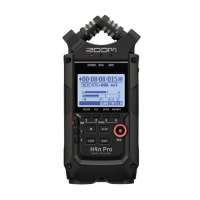
Do you have a question about the Zoom H4n Pro and is the answer not in the manual?
| Recording modes | - |
|---|---|
| Built-in microphone | Yes |
| Maximum recording time | 68 h |
| Audio formats supported | MP3, WAV |
| Media types supported | Flash card |
| Compatible memory cards | SD, SDHC |
| Built-in memory capacity | 2 GB |
| Product color | Black, Silver |
| Channels quantity | 4 channels |
| Number of folders messages | 100 |
| Battery capacity | 2450 mAh |
| Battery technology | Nickel-Metal Hydride (NiMH) |
| Compatible battery sizes | AA |
| Number of batteries supported | 2 |
| Display type | LCD |
| Display resolution | 128 x 64 pixels |
| Output power | 400 mW |
| Number of built-in speakers | 1 |
| Interface | USB |
| FM radio | No |
| Depth | 157.2 mm |
|---|---|
| Width | 73 mm |
| Height | 37 mm |
| Weight | 294 g |
Lightweight, compact design with XY mics, speaker, SD card, mixer, and effects.
Multiple modes (STEREO, 4CH, MTR, STAMINA) and multi-track recording.
Versatile jacks, USB audio interface, SD card reader, tuner, metronome.
Proper handling of AC adapter and batteries, including charging and storage.
Guidelines for safe operation, avoiding damage from pressure, liquids, and environmental factors.
Safe connection of cables, minimizing electrical interference, and protecting hearing.
Venue rules and legal prohibitions on unauthorized recording or distribution.
Using recorded music for personal enjoyment only to avoid copyright violation.
Identifies buttons, display, microphones, and controls on the front of the device.
Identifies ports, speaker, tripod mount, and controls on the back and sides.
Use the specified AC adapter for stable power supply.
Use AA batteries, set STAMINA switch for extended use.
Steps to power on: insert SD card, slide switch, turn on instruments.
Disables button operations to prevent accidental input during recording.
Steps to safely turn off the H4n Pro and connected equipment.
Use DIAL to select/confirm; MENU for settings or cancellation.
Using DIAL for cursor movement, adjustment, and menu access.
Connect to PC, select USB mode, frequency, and audio interface.
Notes on sampling rate, effects, and DAW usage.
Lists menu items available for each mode (STEREO, 4CH, STAMINA, MTR).
Shows current folder, project name, and status indicators.
How to select input sources and adjust recording levels for STEREO and 4CH.
How to set input sources for each track in MTR mode.
Steps to confirm mode, set levels, and start/stop recording.
Explains recording format, file naming, and setting marks.
Steps to record 4 channels using built-in and external inputs.
Explains pausing, file naming, format, and marks in 4CH mode.
Options for recording new tracks or overwriting existing ones in MTR mode.
How to set input sources for each track in MTR mode.
How to set output level and pan position for tracks.
Using stereo link, assigning files, and configuring karaoke settings.
Assign files, set punch points, and initiate automatic re-recording.
Guides through setting end points and starting the automatic re-recording process.
Steps to prepare for manual punch in/out during playback.
How to perform and finish manual punch-in/out recording.
Compensates for volume differences by raising low input signals and lowering high ones.
Details types like COMP1 (General), COMP2 (Vocal), COMP3 (Drum), LIMIT1/2/3 with their parameters.
ON/OFF, MID LEVEL, SIDE LEVEL, SOURCE, CH SETTING adjustments.
Technique to capture wide stereo images and its applications.
Setting click on/off, pre-count, and conditions.
Adjusting tempo, sound, pattern, and volume of the metronome.
Steps for using effects: preset, edit, import, record.
Diagrams showing how effects are applied to tracks for mono and stereo signals.
Imports all patches from a selected project into the current project.
Selects and imports individual patches from other projects.
Prepares tracks for karaoke and assigns them.
Adjusts center cancellation, key, and other parameters for karaoke tracks.
How to set start (A) and end (B) points for playback looping.
Explains button operations for controlling AB repeat, stop, and search.
Steps to change file names by inputting characters.
Notes on character limits, duplicate names, and character input order.
Select stereo encode mode, setup mixer, select save location.
How to execute the stereo encode process and handle file name conflicts.
How to set the name and format (stereo/mono) for the bounced file.
Performing the bounce operation to combine tracks into a single file.
Addresses issues like no sound, low volume, and recording interruptions.
Solutions for problems with bouncing, effects, tuner, and computer connection.
Warning about potential interference and measures to correct it.
CE marking indicating compliance with EU directives.